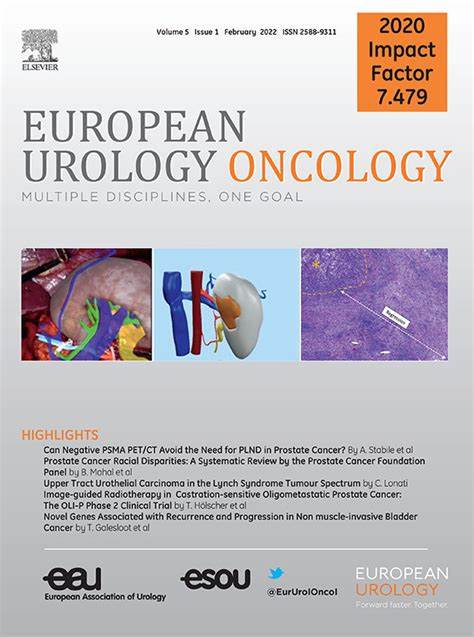深度学习模型在磁共振成像中对有临床意义的前列腺癌进行自动检测、定位和定性的诊断准确性系统性综述》。
IF 9.3
1区 医学
Q1 ONCOLOGY
引用次数: 0
摘要
背景和目的:磁共振成像(MRI)在前列腺癌诊断中起着至关重要的作用,但受限于解释和诊断准确性的可变性。这篇系统性综述评估了深度学习(DL)模型在增强磁共振成像上具有临床意义的前列腺癌(csPCa)的自动检测、定位和定性方面的现状:在 Medline/PubMed、Embase、Web of Science 和 ScienceDirect 上对 2020 年 1 月至 2023 年 9 月间发表的研究进行了系统检索。如果这些研究提出并验证了在 MRI 上检测 csPCa 的全自动 DL 模型,并经病理学确认,则纳入这些研究。研究质量采用诊断准确性研究质量评估-2(QUADAS-2)工具和医学影像人工智能检查表进行评估:25项研究符合纳入标准,在检测和描述csPCa方面显示出良好的结果。但是,由于研究设计、验证策略和数据集存在明显的异质性,使得直接比较变得复杂。只有三分之一的研究进行了外部验证,这凸显了可推广性方面的关键差距。对内部验证的依赖限制了这些发现的更广泛应用,而标准化方法的缺乏则阻碍了DL模型与临床实践的结合:DL模型在改善磁共振成像前列腺癌诊断方面具有巨大潜力。然而,必须解决验证、通用性和临床实施方面的挑战。未来的研究应侧重于方法标准化、确保外部验证和开展前瞻性临床试验,以促进人工智能(AI)在常规临床环境中的应用。患者总结:在这项研究中,我们回顾了人工智能(AI)模型如何帮助医生利用磁共振成像扫描更好地检测和了解侵袭性前列腺癌。我们发现,虽然这些人工智能工具显示出了前景,但这些工具还需要在不同的医院进行更多的测试和验证,然后才能在患者护理中广泛使用。本文章由计算机程序翻译,如有差异,请以英文原文为准。
A Systematic Review of the Diagnostic Accuracy of Deep Learning Models for the Automatic Detection, Localization, and Characterization of Clinically Significant Prostate Cancer on Magnetic Resonance Imaging
Background and objective
Magnetic resonance imaging (MRI) plays a critical role in prostate cancer diagnosis, but is limited by variability in interpretation and diagnostic accuracy. This systematic review evaluates the current state of deep learning (DL) models in enhancing the automatic detection, localization, and characterization of clinically significant prostate cancer (csPCa) on MRI.
Methods
A systematic search was conducted across Medline/PubMed, Embase, Web of Science, and ScienceDirect for studies published between January 2020 and September 2023. Studies were included if these presented and validated fully automated DL models for csPCa detection on MRI, with pathology confirmation. Study quality was assessed using the Quality Assessment of Diagnostic Accuracy Studies-2 (QUADAS-2) tool and the Checklist for Artificial Intelligence in Medical Imaging.
Key findings and limitations
Twenty-five studies met the inclusion criteria, showing promising results in detecting and characterizing csPCa. However, significant heterogeneity in study designs, validation strategies, and datasets complicates direct comparisons. Only one-third of studies performed external validation, highlighting a critical gap in generalizability. The reliance on internal validation limits a broader application of these findings, and the lack of standardized methodologies hinders the integration of DL models into clinical practice.
Conclusions and clinical implications
DL models demonstrate significant potential in improving prostate cancer diagnostics on MRI. However, challenges in validation, generalizability, and clinical implementation must be addressed. Future research should focus on standardizing methodologies, ensuring external validation and conducting prospective clinical trials to facilitate the adoption of artificial intelligence (AI) in routine clinical settings. These findings support the cautious integration of AI into clinical practice, with further studies needed to confirm their efficacy in diverse clinical environments.
Patient summary
In this study, we reviewed how artificial intelligence (AI) models can help doctors better detect and understand aggressive prostate cancer using magnetic resonance imaging scans. We found that while these AI tools show promise, these tools need more testing and validation in different hospitals before these can be used widely in patient care.
求助全文
通过发布文献求助,成功后即可免费获取论文全文。
去求助
来源期刊

European urology oncology
Multiple-
CiteScore
15.50
自引率
2.40%
发文量
128
审稿时长
20 days
期刊介绍:
Journal Name: European Urology Oncology
Affiliation: Official Journal of the European Association of Urology
Focus:
First official publication of the EAU fully devoted to the study of genitourinary malignancies
Aims to deliver high-quality research
Content:
Includes original articles, opinion piece editorials, and invited reviews
Covers clinical, basic, and translational research
Publication Frequency: Six times a year in electronic format
 求助内容:
求助内容: 应助结果提醒方式:
应助结果提醒方式:


